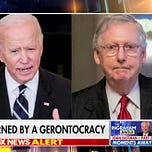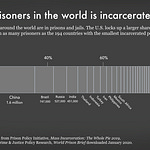This Sunday, The Guardian’s David Smith published an editorial about gerontocracy in Washington. It explores whether our nation’s ruing class is “too old to govern,” noting how both parties share an interest in sweeping under the rug the advancing age of their respective leaders, who Larry Jacobs, director of the Center for the Study of Politics and Governance at the University of Minnesota, described as “decrepit.”
A “senior moment” is no laughing matter
The spectacle of the Senate Majority Leader freezing at the podium last month—and again last week—inspired any number of clever memes, and a pointed reflection from at least one presidential candidate (with whom I agree on little else).
But despite the righteous outrage channeled towards a figure who has laughed all the way to the bank for decades while enriching one industrial complex after another, 81-year-old Mitch McConnell is not the problem.
Nor is Joe Biden, the 80-year-old president whose administration has abandoned his campaign promises while doubling down on fossil fuel extraction, senseless wars serving no purpose beyond padding the profits of weapons manufacturers, and restrictions on labor rights enabling an upward transfer of wealth that continues across the United States and the rest of the world.
Nor is Dianne Feinstein, the 90-year-old oligarch whose career representing California in the Senate has enabled GOP policy priorities for decades. She went conspicuously missing for several weeks this spring, imperiling judicial appointments and largely bringing the Senate to a screeching halt, before making oblivious public claims that ran perhaps the greatest risk of proving Nikki Haley right.
Nor is Donald Trump, the 77-year-old former President and would-be tyrant whose mendacity and racism found support in a fascist cult of personality that continues to grow despite—and perhaps due to—his mounting criminal prosecutions and vilification by a press establishment that more or less created him and placed him in the White House in the first place.
Each of these figures are senior citizens. Responding to a Washington Post editorial exploring whether Biden’s age should be a factor in the 2024 election, one reader praised Biden, suggesting that his “running [for re-election] is one of the bravest, most selfless things I’ve ever seen in politics.” Another concerned reader replied, observing that “There is nothing ‘selfless’ about holding public office well into your 80s and refusing to leave until carried out feet first.”
Other readers who wrote to the Washington Post noted how long-serving officials refuse to make space for younger voices. But the dynamic they observe is offensive for many other reasons, for better or worse.
To describe Washington as a gerontocracy is frankly charitable….[T]heir individual incapacity is just part of the problem, ultimately akin to the part of an iceberg that looms above the water.
Gerontocracy invites institutional—not just individual—incapacity
Some voices looked beyond McConnell’s senior moments each of the last two months, Biden’s frequent disorientation and recurring refusals to respect the right of women to set and maintain their own boundaries, Feinstein’s confusion about her own month-long absence from the Senate, and Trump’s equally advancing age and legendary incoherence to identify the ultimate problem as gerontocracy: rule by the old.
But to describe Washington as a gerontocracy is frankly charitable.
Concerns about gerontocracy center on mental fitness, and the capacity of people as they advance in age to execute their duties. Each of the figures above have revealed their unfortunate incapacity.
But their individual incapacity is just part of the problem, ultimately akin to the part of an iceberg that looms above the water.
The GOP has no monopoly on gerontocracy
Voices who connected McConnell freezing to Biden frequently losing his train of thought made one important—and accurate—observation. For better or worse, the crisis illustrated by their shared incapacity is bipartisan.
The president is barely younger than the Senate Majority Leader, and seemingly equally prone to what some might fondly describe as “senior moments.” He is joined by any number of other aging figures in Washington, from Feinstein to 83 year-old Nancy Pelosi, the former Speaker of the House.
Why are so many of the most powerful figures in the world so old that they won’t likely ever face the consequences of their own policy decisions? The heads of both corporate political parties in Washington are so reliant on paid staff that their decisions stretch the bounds of democratic theory premised on electoral accountability. If the people making the decisions are not themselves electorally accountable, how can the electorate “vote our way out of this?”
The rot exposed by this ossification is not merely individual, nor is it only politically bipartisan. Its constitutional dimension is even worse than the sum of its parts.
Institutional incapacity ossifies governance
When the Founders crafted the constitutional design under which we have lived for the past 250 years, they specifically intended some institutions to “cool the passions” of the Republic. Some, like scholar Charles Beard, have described their construct as specifically intended to limit the capacity of the “tyranny of the majority” to legislate economic redistribution.
The courts were constructed to slow democracy
Not only were the courts charged with guarding rights from the “tyranny of the majority,” but the Supreme Court soon claimed the power to strike down acts of Congress (or state legislatures) that violate one or another constitutional principle. Over the Court’s long history, many of those princples were effectively invented by Justices appointed for life with no avenue for public accountability.
Sound familiar?
In an earlier era, those principles included the contrived idea that any attempt at guarding workers presaged economic redistribution, and therefore unconstitutionally exceeded the legitimate powers of government. That was the rationale behind the infamous Lochner v. New York decision that in 1905 invalidated labor reforms passed by the State of New York to protect the health & safety of bakers.
In Lochner, The Justices imagined laissez faire economic policy to be a constitutional mandate, imposing their will on the People of the United States despite the actions of our elected representatives. They abandoned any semblance of democracy in the process. That was a hundred years ago.
Many liberals have seized on the subsequent history—when FDR cleverly intimidated the Court by threatening to add new seats, ultimately leading the Court to repudiate its untenable position 22 years after Lochner, in West Coast Hotel v Parrish—as a recipe for reigning in the arbitrary and reactionary conservatism of the Roberts Court and its contemporary attack on principles including reproductive freedom.
That linear thinking is both lazy and also dangerous since it ignores the contemporary context and would ultimately lead a leap from a frying pan into a fire. But I digress….
The Senate was designed as a counterweight to the House
Like the Supreme Court, the Senate was crafted as an institution intended to “cool the passions” of the Republic, which were supposed to principally emerge from the House of Representatives.
The House is composed of members elected every two years, apportioned across the states in proportion to their populations. Because Members have among the shortest terms of any elected office, they are presumed to be maximally responsive to concerns that emerge within their constituencies.
The House was supposed to represent We the People of the United States.
In contrast, the Senate was designed to represent the states. Senators are elected every six years in order to insulate them from the day-to-day tussle of power in Washington, and popular controversies that the Founders envisioned flipping seats in the House. Unlike the House, which is largely limited to proposing legislation, the Senate has the power to reject executive appointments, reject judicial appointments, ratify treaties, and block bills proposed either by the President or by the House.
The institutional brakes embodied in the Supreme Court and the Senate are arguably problematic in themselves. Any structure designed to “cool the passions” of a people who supposedly run the show ultimately reeks of paternalism.
They also limit innovation and stagnate collective decision-making. That’s especially dangerous during any time when our nation confronts multiple crises—climate chaos, global pandemics, social fractures—to which the established order has no credible response.
But whatever one thinks of the idea of brakes built into the Constitution, or their unfortunate impacts during times of change requiring institutional nimbleness, they are made even more dangerous by the transformation of the House of Representatives into an ossified chamber of self-protecting careerists.
Every branch in Washington now plays the same role
The House was supposed to represent the passions of We the People, but has instead become trapped by the same individual careerism—and institutional ossification—that infects the other branches. This structural co-optation of the House turned the entire constitutional design on its head long ago.
The re-election rate in Congress is astronomically high. That is driven not by the passions of the voters, but particularly by political inertia fueled, in turn, by many factors: name recognition, the franking privilege (through which Members—but not challengers—can reach voters for free through the U.S. Postal Service), the tendency of corporate incumbents to smear their opponents, and the media’s foolish willingness to frame elections as horse races without any attention to policy, the public failures of incumbents, or the substantive alternatives offered by challengers.
The House is in no way poised to reflect the passions of We the People that the other branches were constructed to cool.
The re-election rate in Congress also represents the co-optation of democracy by capital, in at least three dimensions.
Listen to this episode with a 7-day free trial
Subscribe to Chronicles of a Dying Empire to listen to this post and get 7 days of free access to the full post archives.













